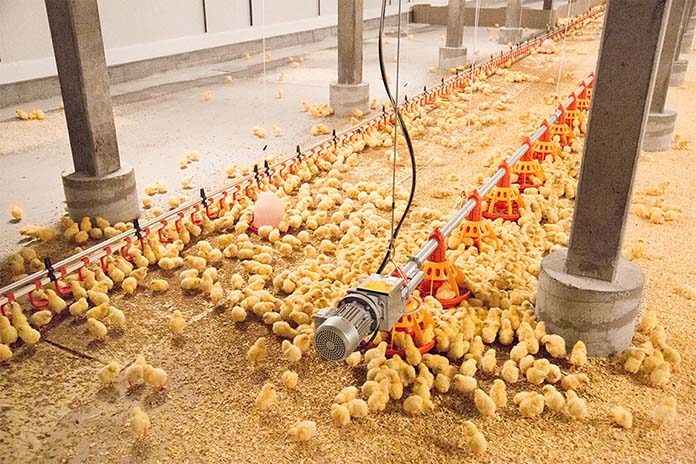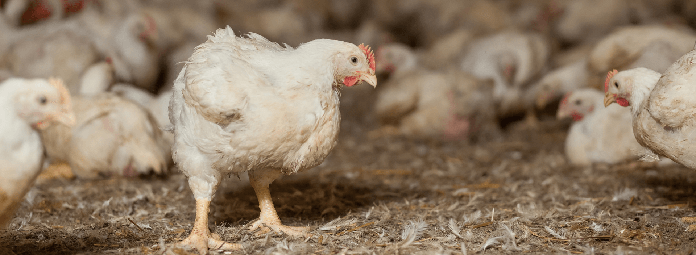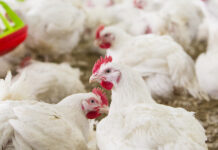
The apparent metabolisable energy (MJ/kg dry matter) values for wheats were determined in two conventional energy balance experiments on meat chickens. A blend of xylanase and phytase enzyme products was used in both experiments.
In experiment 1, main effects of gender, breed, feed enzymes and wheat sample were significant (P<0.001). Ability of meat chickens to extract energy from a semi-purified wheat diet formulation was highly breed-dependent, with Ross 308 chickens being superior to Cobb 500 chickens (14.61 versus 13.15 MJ/kg dry matter). Furthermore, within Ross 308, females were superior to males (14.79 versus 14.42 MJ/kg dry matter), whereas there was no difference due to gender in Cobb 500. In experiment 2, main effects of gender, feed enzymes and wheat sample were significant (P<0.001). There was a significant interaction (P<0.05) between wheat sample and enzyme addition to diets fed to Cobb 500 chickens. Ten samples of wheat out of a total of 29 showed a significant increase in AME values due to enzyme addition, with improvements ranging from 1.15 to 2.31 MJ/kg dry matter.
Cereal grains used by the poultry industry in Australia vary widely in available energy and protein contents which are often reflected as variation in bird performance. Gender and the “new season” grain phenomenon have been shown to affect the ability of meat chickens to draw energy from cereal grains, particularly wheat. Moreover, exogenous feed enzyme products are used in meat chicken diets to overcome the anti-nutritive effects of non-starch polysaccharides and phytate, but not always successfully.
Rapid techniques based on near infrared reflectance (NIR) have been developed for measuring the apparent metabolisable energy (AME) content of cereal grains for meat chickens to improve the accuracy of feed formulation. An unpublished research completed to date suggests that the global NIR calibrations, where all grains were used to establish the calibration, overestimate the AME values of some wheat samples. This limitation could be resolved by inclusion of a larger number of samples in the NIR data base, particularly in the lower end of the AME range. Because there have been no ‘new season’ grains evaluated to date, the robustness of calibrations could be greatly enhanced by addition of low AME new seasons wheat grains.
Data underpinning NIR calibrations (AusScan) and earlier work show that male and female chickens can respond differently when fed diets based on the same wheat samples. In addition to gender, breed may also affect responsiveness to different wheat samples. There are two main breeds of commercial meat chickens used in Australia. The AusScan database is built on results from only one breed of chicken (Cobb 500), which shows different phenotypic traits to the other breed (Ross 308) in terms of growth rate and feed efficiency. The concern is that these differences also may extend to ability to extract energy from cereal grains in the diet. The study reported here compared AME values measured with Cobb 500 and Ross 308 meat chickens fed four wheat-based diets without and with feed enzymes in Experiment 1, and Ross chickens fed 29 wheat-based diets without and with feed enzymes in Experiment 2. In both experiments, effects of gender were also determined.
Materials and methods
The AME values of wheats were determined in conventional energy balance studies involving measurements of feed intake and excreta output as described by Mollah et al. (1983) with minor modifications, and subsequent measurement of gross energy values of feed and excreta by bomb calorimetry.
Experiment 1 was a factorial design involving breed (Ross 308 and Cobb 500), gender (male and female), enzymes (without and with) and wheat (four wheats grown in 2013) with each combination replicated twice.
Experiment 2 was also a factorial design involving Ross 308 meat chickens, gender (male and female), enzymes (without and with) and 29 wheats with each combination replicated twice.
Each experiment was conducted with two separate batches of day-old, feather-sexed broiler chickens raised in floor pens on a commercial broiler diet to 22 days of age and then transferred in single-sex groups of five to metabolism cages in controlled temperature rooms.
Air temperature was maintained at 26°C at the start of the 7-day experiment and lowered daily until it was 23°C at the end. Experimental diets contained per kg wheat 800g, acid casein 155g, dicalcium phosphate 20g, limestone 11g, DL- methionine 7g, mineral and vitamin premix 3g, salt 2g, and choline chloride (60) 2g. All wheats were fed with and without a blend of xylanase (Porzyme 93010 at 50 g/tonne) and phytase (Phyzyme TPT at 50 g/tonne) enzyme products.
Dietary treatments were replicated four times (two cages of males and two cages of females). Cold-pressed diets were fed for seven days (birds 22-29 days of age). The first three days enabled the chickens to adapt to the feeds. During the following four days, all excreta were collected and dried at 85°C. Feed intake was measured during the adaptation and collection phases of the study. Birds were weighed at the start and end of the 7-day period (data not shown). Dry matter contents of samples of pelleted and milled feeds were measured. Gross energy values of dried excreta and milled feeds were measured with a Parr isoperibol bomb calorimeter. AME of the grain was calculated by subtracting from total energy intake the energy contribution of casein, which was assumed to be 20.1 MJ/kg dry matter.

Results
In Experiment 1, main effects of gender, breed, enzyme and wheat on AME values were significant (P < 0.001; results not shown). The key finding was a significant interaction (P<0.05) between gender and breed. For each gender, Ross 308 chickens had higher AME values than Cobb 500. There was no difference due to gender for Cobb 500 chickens, whereas for Ross 308 the AME value averaged over four wheat samples was 0.37 MJ/kg dry matter higher for female compared with male chickens. Two-way interactions involving breed, gender or enzyme were not significant, nor was the interaction involving all three effects, which indicates that response to feed enzymes was consistent across breed and gender.
In Experiment 2, main effects of gender, enzyme and wheat on AME values were significant (P<0.001; results not shown). There was a significant interaction (P<0.05) between wheat sample and enzyme addition.
Discussion
Ability of meat chickens to extract energy from a semi-purified wheat diet formulation was highly breed-dependent. Ross 308 chickens were superior to Cobb 500 chickens (14.61 versus 13.15 MJ/kg dry matter). Furthermore, within Ross 308, females were superior to males (14.79 versus 14.42 MJ/kg dry matter), whereas there was no difference due to gender for Cobb 500. Given the commercial implications of the effect of breed, further investigations under both experimental and commercial conditions are warranted to confirm the finding and identify reasons for the breed differences.
Ten samples of wheat out of a total of 29 showed a significant increase in AME values due to enzyme addition. Significant differences in AME due to feed enzymes ranged from 1.15 to 2.31 MJ/kg dry matter. AME was significantly increased in seven of the ten wheats with AME values less than 13 MJ/kg dry matter, whereas only three of the 19 wheats with higher AME (>13 MJ/kg dry matter) were responsive to this blend of xylanase and phytase enzyme products. These results suggest that factors other than anti-nutritive effects of no starch polysaccharides and phytate are at least partially responsible for variation in AME values for wheat. For example, Truong et al. (2015) concluded that phytase may impede starch digestion in wheat- and maize-based diets. The ecology of the chicken gut microbiota has been implicated as yet another source of variability in energy metabolism and feed efficiency.
References are available on request
From the Proceedings of the Australian Poultry Science Symposium














